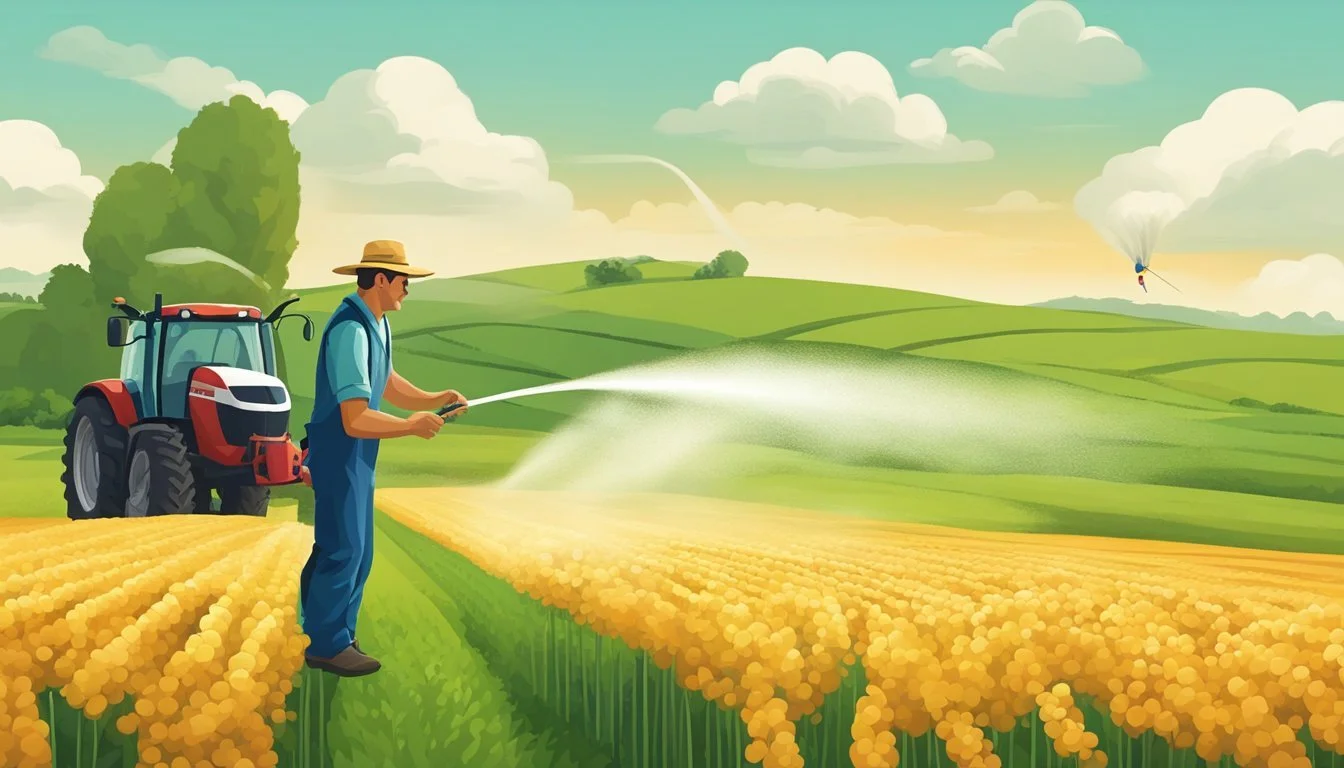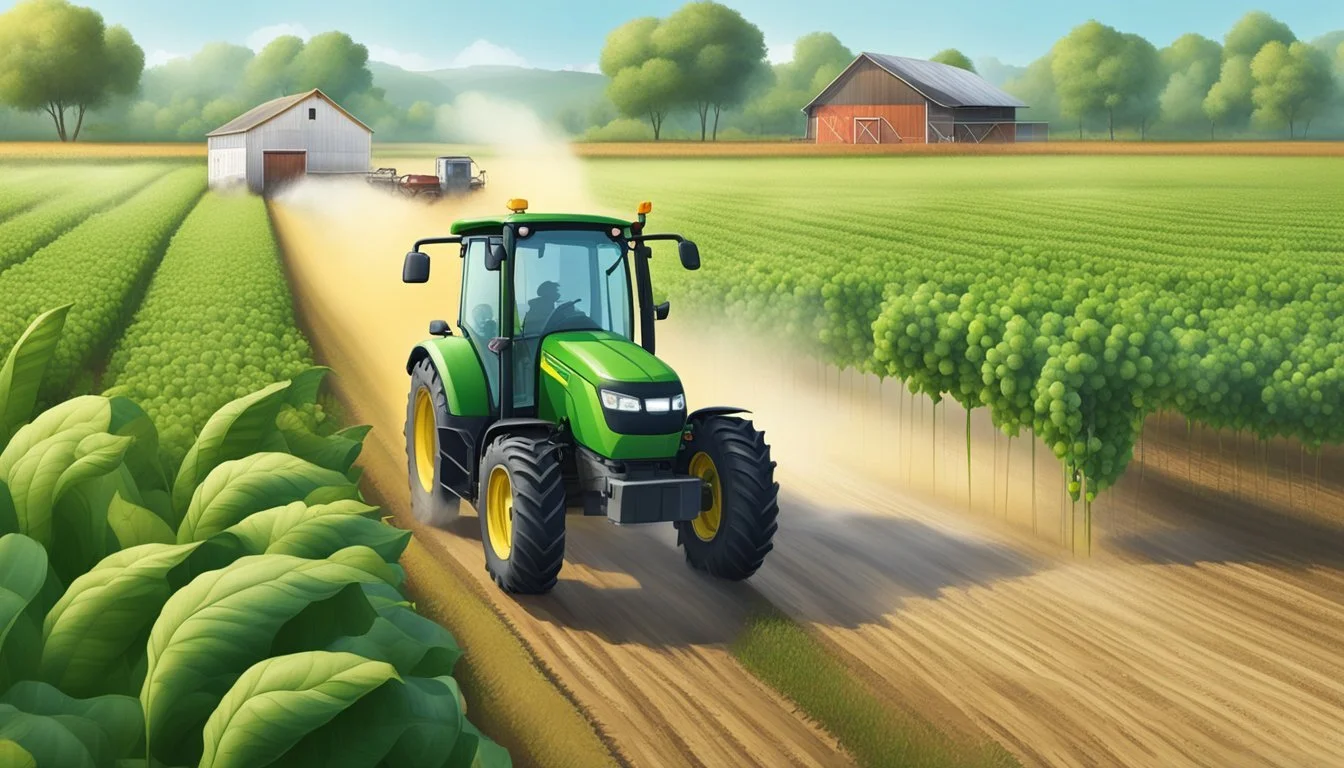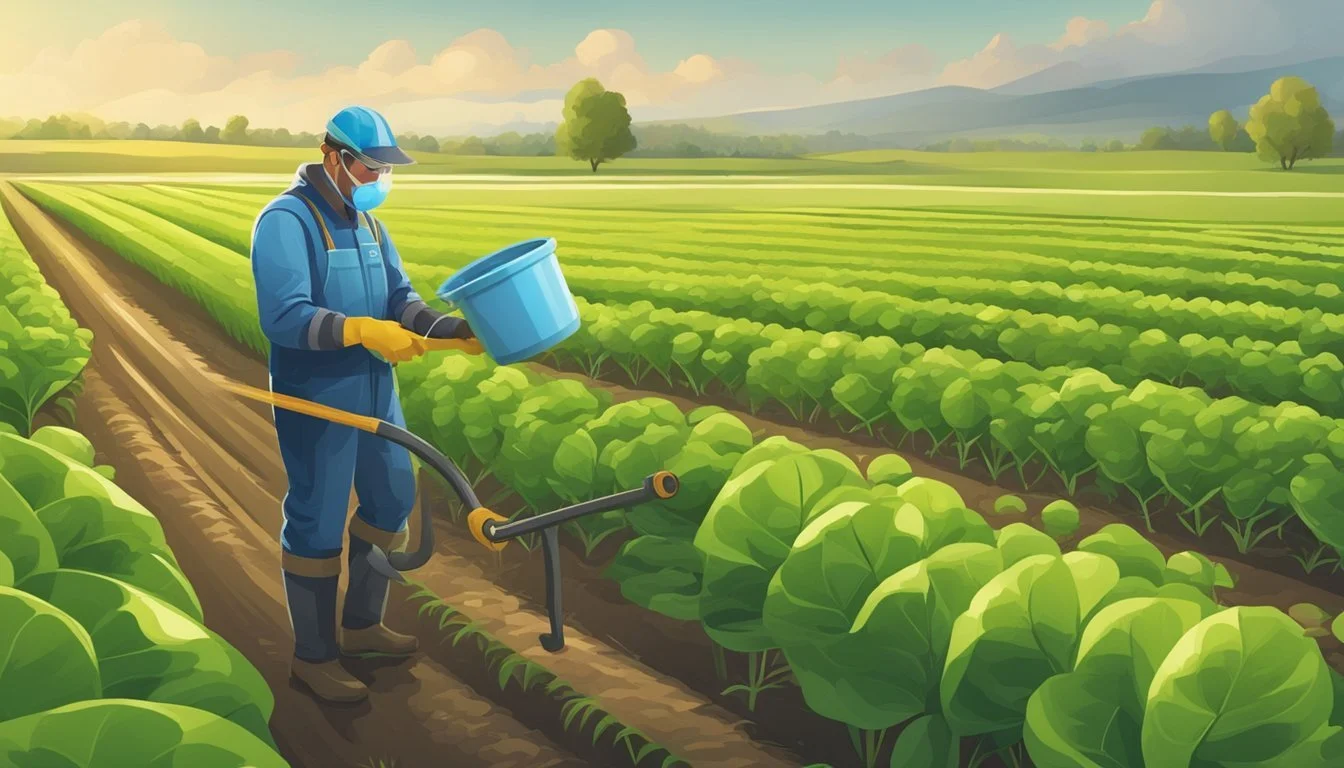Pesticide Drift Management
Strategies for Minimizing Off-Target Movement
Pesticide drift management is a critical aspect of agricultural practices that has significant implications for the environment, human health, and water resources. Pesticide drift occurs when pesticide droplets, intended for a specific target area, are carried by the wind to other locations. This can result in unintentional exposure of non-target crops, wildlife, and water bodies to chemicals, potentially causing harm.
Consequently, effective strategies to manage spray drift are essential. These strategies involve adjusting application techniques, such as optimizing nozzle type, operating pressure, and spray height. Adjustments are made to minimize the creation of fine droplets that are more likely to be carried by the wind. In addition, weather conditions such as wind speed and direction are closely monitored to reduce the risk of drift during pesticide application.
Balancing the need to protect crops from pests with the responsibility to safeguard surrounding ecosystems is a complex challenge. It requires ongoing research and technological innovation aimed at developing Drift Reduction Technology and best management practices. These advances benefit both agricultural productivity and environmental stewardship, ensuring that pesticide applications are precise, effective, and minimally invasive to the environment.
Understanding Pesticide Drift
Pesticide drift is a critical concern in agricultural practices, referring to the unintended movement of pesticides away from their target area during or after application, which can affect surrounding environments and communities.
Forms of Pesticide Drift
Spray Drift occurs when pesticide droplets are carried by wind during application, leading to the deposition of these droplets on non-target areas. This form of drift is immediately noticeable and can be mitigated through careful application techniques. The US EPA provides guidelines on how to minimize spray drift to protect non-target sites.
Vapor Drift, on the other hand, involves pesticides turning into gas or vapor post-application, potentially traveling long distances and affecting areas far from the site of initial use. Vapor drift is influenced by the volatility of the pesticide compound and can occur well after the application has been completed.
Factors Affecting Pesticide Drift
Several elements influence the likelihood and extent of pesticide drift, and understanding these can lead to more effective drift management strategies:
Wind Speed and Direction: Higher wind speeds increase the potential for drift. Directions can dictate where drifting pesticides may end up.
Nozzle Type: The design and size of spray nozzles impact droplet size, with finer droplets being more prone to drift.
Application Height: Lowering the height of pesticide release can reduce drift; aerial applications should be minimized.
The Environmental Protection Agency (EPA) plays a pivotal role in mitigating pesticide drift by regulating application techniques, advocating for drift management practices, and overseeing the approval and labeling of pesticides to ensure environmental protection.
Health and Environmental Impact
Pesticide drift poses significant risks to human health and the environment, affecting various entities including wildlife, water bodies, and crops. Proximity to schools and playgrounds exacerbates concerns over exposure to pesticide residues.
Effects on Human Health
Direct exposure to pesticides due to drift can lead to acute health issues such as skin and eye irritation, respiratory problems, and systemic toxicity in humans. It is particularly concerning for individuals living near treated agricultural areas. The U.S. Environmental Protection Agency (US EPA) outlines that risks are not confined to agricultural workers but also affect nearby communities.
Effects on Wildlife and Ecosystems
Wildlife suffers from unintended pesticide exposure, with effects ranging from immediate toxicity to long-term ecological imbalance. Pesticides may reduce beneficial insect populations and harm non-target species, disrupting food chains and ecosystem dynamics. Habitat contamination, as described in research on agriculture and pesticide application, underscores the broader environmental effects of pesticide drift.
Contamination of Water Bodies
Pesticide drift contributes to the contamination of water resources. Runoff from drift can enter streams, rivers, and lakes, posing a threat to aquatic life and potentially affecting water quality for human consumption. The mobility of pesticide residues is a serious concern for environmental safety and public health, according to the EPA's considerations on spray drift.
Drift Management Strategies
Effective drift management strategies minimize the off-target movement of pesticides, ensuring they reach the intended target while reducing potential environmental and health risks. These strategies emphasize the importance of selecting appropriate pesticides, adopting advanced equipment and technology, employing proper application techniques, and taking into account the prevailing weather conditions during application.
Pesticide Selection
Choosing the right pesticide is crucial for drift management. Products with lower volatility are preferred, as they are less likely to vaporize and move from the target area. It's essential to read and follow the label directions, as they contain specific information on the product's potential to drift.
Equipment and Technology
Utilizing modern application equipment can significantly reduce pesticide drift. Spray nozzles that produce larger droplets, such as low-drift nozzles, hydraulic nozzles, or air induction nozzles, are effective in combatting drift. Nozzle selection should align with the application's requirements according to the pesticide label guidelines.
Application Techniques
Applying pesticides correctly plays a vital role in drift management. Techniques like keeping the spray boom at the lowest possible height that still provides uniform coverage and using the appropriate spray pressure can lower drift potential. Additionally, shielding spray nozzles can help confine the pesticide to the intended area.
Weather and Timing
Weather conditions, including wind speed, air temperature, and humidity, have a substantial impact on pesticide drift. Applications should be avoided during high wind speeds or during temperature inversions, when a stable layer of warm air above cooler air can trap and move pesticides unpredictably. Planning applications for times of day with favorable conditions is crucial for successful drift management.
Regulatory and Legal Aspects
Efficient management of pesticide drift is crucial, with the Environmental Protection Agency (EPA) taking the lead on regulatory measures while additional legal frameworks govern usage and dispute resolutions. Compliance with label directions is imperative, and the establishment of buffer zones helps protect sensitive areas.
EPA Regulations and Compliance
The EPA has set forth stringent regulations to manage the risks associated with pesticide drift. Manufacturers must ensure their products meet safety standards before entering the market, with the EPA evaluating the potential for drift during the registration process. These assessments include factors like release height and wind speed, influencing the likelihood of drift and potential impact on non-target areas.
Label Directions and Usage
Pesticide labels, overseen by the EPA, serve as a legal document providing critical information on the proper use of products. Every pesticide label outlines specific instructions on application methods, appropriate conditions, and limitations to minimize off-target drift. Users must adhere strictly to these label requirements to ensure compliance and minimize environmental and legal risks.
Application methods: Detailed to control drift.
Conditions: Such as wind speed limits.
Limitations: Including no-spray zones.
Buffer Zones and Sensitive Areas
Buffer zones act as safeguarding perimeters, establishing a no-application zone to protect sensitive areas from unintended pesticide exposure. Regulations may vary by state but are fundamentally geared towards environmental justice, ensuring that sensitive ecosystems, schools, or residential zones are shielded from the effects of drift. The concept and enforcement of buffer zones highlight an intersection of law and environmental protection, furthering the overall objective of maintaining ecological balance and community health.
Advanced Drift Research and Innovations
In the realm of agricultural sciences, pesticide drift management is gaining traction through cutting-edge research and technology. These advancements are instigated by the efforts of agricultural engineers and academicians from leading institutions such as North Dakota State University.
Current Research and Results
Recent studies have illuminated the mechanics of pesticide drift, unveiling the factors that influence the dispersal of pesticides beyond their intended targets. Research at institutions like North Dakota State University has generated results showing the impact and mitigation of drift. Findings indicate that environmental conditions, spray application methods, and nozzle types all play crucial roles in the extent of pesticide drift. For instance, a study from the US EPA has underscored the significance of droplet size on drift potential, advocating for optimized spray technologies to control droplet dispersion.
Key Factors Influencing Drift:
Environmental conditions (wind speed, temperature)
Application methods (equipment type, application speed)
Nozzle design (droplet size, spray quality)
These insights have propelled initiatives to develop guidelines and policies that minimize unintended pesticide spread, preserving both the environment and neighboring crops.
Technological Advancements
On the technological front, the agriculture industry has witnessed substantial progress in drift reduction technology (DRT). Enhancements in application equipment are central to this progress, with designs that refine spray quality and deploy larger droplets that are less prone to drift. The EPA has advocated for such innovations, leading to the development of drift-reducing nozzles and precision spraying equipment. Agricultural engineers are at the forefront, crafting tools that integrate GPS and weather data to modulate spray operations in real time.
Notable Technological Developments:
Drift-Reducing Nozzles: Designed to produce larger droplets for minimal drift.
Precision Spraying Equipment: Utilizes GPS and real-time weather data to adjust spraying parameters accordingly.
These advancements not only curb the environmental and health hazards linked to pesticide drift but also enhance the efficacy and sustainability of pesticide application in modern agriculture.
Practical Guidance for Applicators
To effectively manage pesticide drift, applicators must adhere to stringent protocols that encompass education, operational best practices, and thorough monitoring and assessment. These measures safeguard the interests of growers and farm workers while ensuring environmental compliance.
Education and Training
Education serves as the bedrock for competent pesticide applicators. They are encouraged to participate in programs sponsored by the National Agricultural Aviation Association to advance their aeronautical decision-making skills. Continual professional development is crucial, not only for compliance but also for maintaining the highest best practices standards in spray drift management.
Operational Best Practices
Applicators must utilize an inventory of best management practices during pesticide applications. This includes selecting the correct nozzle type, adjusting the nozzle height, and managing operating pressure to minimize drift potential. It is recommended that applicators do not rely solely on these factors but integrate crop and environmental considerations into each application scenario. For example, avoiding spraying during high winds can substantially reduce drift occurrences. Ground application strategies have been meticulously outlined in reviewed literature, supported by research data to mitigate spray drift.
Monitoring and Assessment
For systematic monitoring and assessment, it is essential that applicators both observe and document all spray sessions. Assessments should be regular and detailed, including notes on the conditions of pesticide applications and the presence of sensitive areas. Moreover, acting upon the feedback from the Drift Reduction Technology program can significantly aid in refining the application processes. Through conscientious monitoring, potential drift can be detected early, and corrective actions can be promptly implemented, thereby ensuring the protection of health and the environment.
Community and Industry Initiatives
Effective management of pesticide drift is a shared responsibility among agricultural communities, environmental bodies, and industry stakeholders. They have converged on several initiatives that focus on sustainable practices, conservation programs, and involve constant dialogue with the community to mitigate the adverse impacts of pesticide drift.
Sustainable Agriculture
Sustainable agriculture is a primary focus for reducing pesticide drift, with industry leaders embracing technologies that ensure targeted application. The US EPA is involved in minimizing pesticide drift through improving scientific models and methods for estimating drift. They advocate for precision spraying techniques and the development of drift reduction technologies (DRTs) that enhance application accuracy.
Environmental Stewardship Programs
Environmental stewardship programs are instrumental in guiding industry practices towards more environmentally friendly methods of pest control. These initiatives largely depend on collaboration with various stakeholders, including state and federal agencies, to promote the use of equipment designed to reduce spray drift. Such endeavors are often supported by the establishment of educational resources for communities, exemplified by the training provided by Virginia Cooperative Extension, teaching how to minimize drift in pesticide application.
Community Engagement and Feedback
Community engagement ensures that those most affected by pesticide drift have a voice and a means to report a problem. The US EPA encourages feedback from community members who can contact them directly with concerns, demonstrating a transparent pathway for both lodging issues and obtaining advice. Active dialogues between farmers, residents, and local extension agents foster a sense of communal responsibility and lead to the collective development of better pesticide management practices.
Frequently Asked Questions
In this section, we address critical concerns related to pesticide drift, its health implications, best management practices, methods to minimize risks, relevant regulations, contributing factors, and impact of distance on exposure.
What are the potential health impacts of pesticide drift on humans?
Pesticide drift can lead to a range of health issues for humans, including respiratory problems, skin irritation, and more serious long-term effects such as impacts on the nervous system or hormonal disorders. The severity of these impacts often depends on the level and duration of exposure.
How can agricultural workers manage pesticide drift effectively?
Agricultural workers can manage pesticide drift by using drift reduction technology (DRT) and following best application practices, such as proper nozzle selection and maintaining appropriate spray pressures. Training on the safe use of pesticides and adherence to label instructions is also crucial.
What methods can be used to minimize the risk of pesticide drift?
To minimize the risk of drift, one can make use of buffer zones, select the time of application carefully to avoid high wind speeds and temperature inversions, and employ technologies like shielded sprayers that target the application more precisely.
What regulations govern pesticide drift and its enforcement?
Pesticide drift is under the regulatory purview of agencies like the US EPA. They establish guidelines and enforceable limits on acceptable levels of pesticide drift, while also requiring explicit labeling on pesticide products that detail drift management and mitigation measures.
What factors contribute to the risk of pesticide drift occurrences?
Factors contributing to the risk include weather conditions like wind speed and direction, the type of application equipment used, spray particle size, and the physical properties of the pesticide formulation. Understanding these factors is essential in the planning and execution of pesticide applications to reduce drift.
How can the distance from the application site affect pesticide drift exposure?
The distance from the application site is a critical factor in pesticide drift exposure; generally, the closer one is to the point of pesticide application, the greater the risk of exposure to pesticide drift. This necessitates careful consideration of wind patterns and buffer zones to protect surrounding areas.






